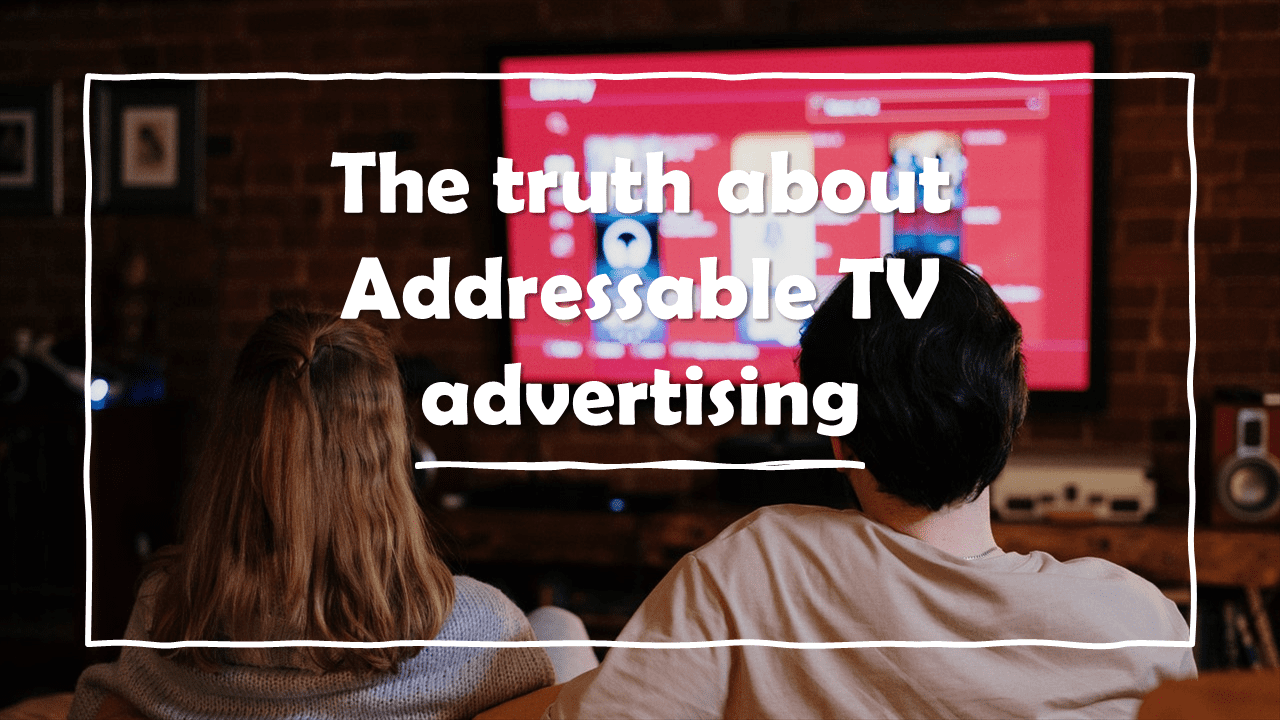If you have discounted the possibility of entering the world of TV advertising, here's why it's time to have a major re-think!
How does TV advertising compare with other media in terms of ROI?
Even before we take a look at the difference the revolutionary addressable TV advertising is making to growing brands, there is already substantial evidence proving the value TV adverts offer to brands over and above other mainstream media. A study commissioned by Thinkbox 'Profit Ability: the business case for advertising (2018), by Ebiquity and Gain Theory", showed it was still by far the most powerful media, even after two decades of advances with digital media.
- Across 2,000 advertising campaigns over 11 categories to uncover the impact that different forms of advertising have on short-term profit
- Analysed results throughout the campaign and within 3–6 months of the campaign finishing
- Then combined these learnings with results for profit generated over the longer term (up to 3 years on) to determine total profit return.
This indicated that overall, TV advertising generated 71% of profit alongside all other forms of advertising.
To see the full study CLICK HERE
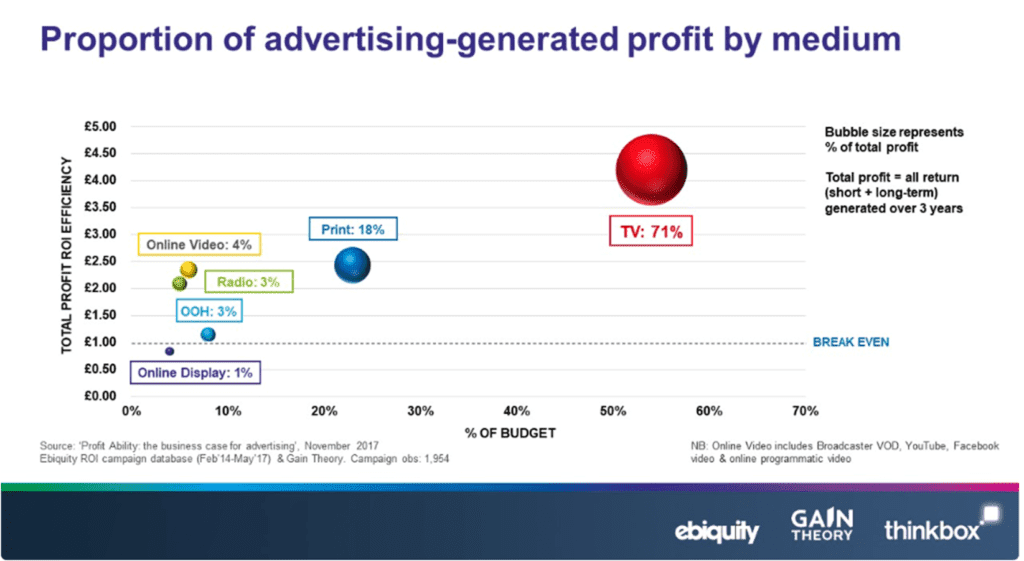
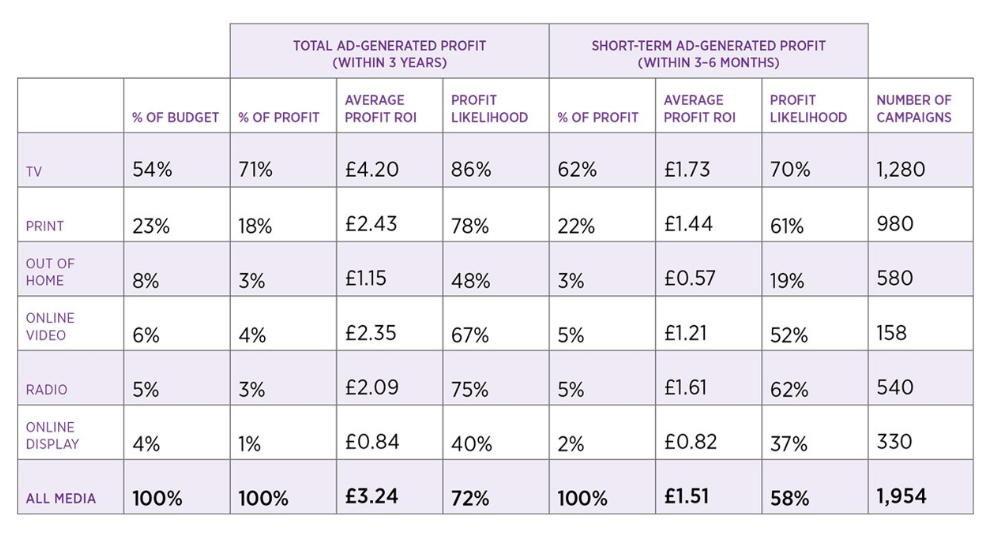
TV advertising is just for rich companies with big budgets - right?
Wrong. The cost to air a TV advert on the major two biggest channels ITV and Sky is competitive with Google Ads, Radio and Magazine advertising where the typical start point will be monthly budgets of £3K to £10K.
ITV has no minimum spend. Even Sky's premium AdSmart service can be afforded with a budget of just £5K per monthly campaign.
Then the only other cost is the actual cost of the TV advert and a small amount of administration. Basic Adverts can be created for as little as £2K.
At the same time, online advertising is becoming expensive. Just look at Facebook and Google, it costs more to run an ad now than it did a year ago.
- Google and YouTube went up by 108%
- Facebook had up to an 89% increase, while the average CPM was $11
- TikTok has a 92% increase
- and Snapchat with “the lowest” at a 64% increase.
This amazing affordability is the direct result of the revolution created by Addressable TV Advertising.
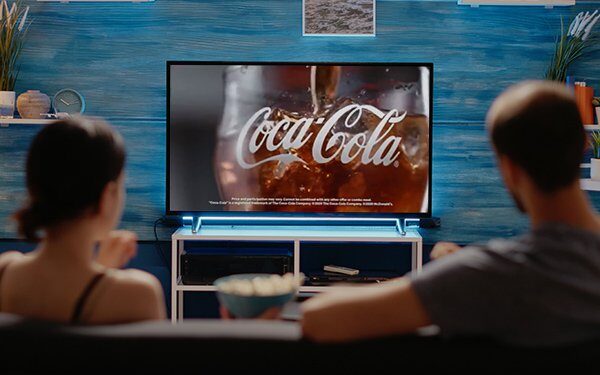
What's really different about the latest forms of TV advertising?
TV advertising was originally bound by 'slots' bought on channels. You paid for 'airtime' according to the predicted number of viewers and what you paid depended on the type of programmes where your advert appeared and chose between nationwide or regional coverage. This is called linear TV advertising and the method is still used today.
The arrival of internet 'Connected TV' often known as SMART TVs has allowed a much more effective form of advertising to be launched in the UK. This is called 'addressable TV advertising' and uses similar principles to the way Google Ads can target individuals, by where they are, what things they like watching, and what they purchase regularly. Addressable TV precisely targets households and subscribers with the same criteria. So the advertiser can now purchase audiences, and ensure their advert is seen by those most likely to engage and want their products. Because the TVs are connected over the Internet you can also track who has watched the advert and match this with sales data to get an enhanced view of return on investment.
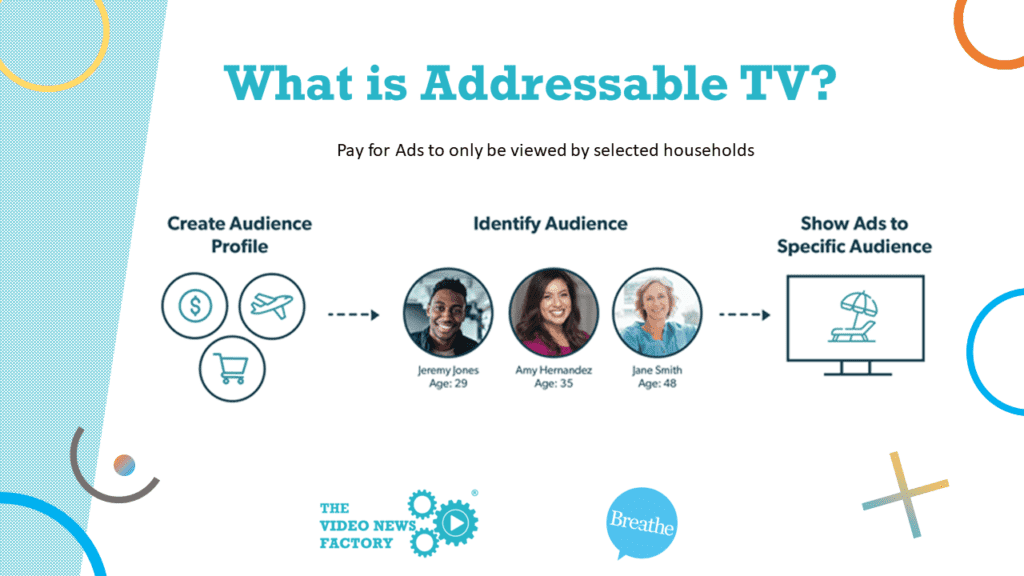
How has Addressable TV advertising benefited advertisers?
Since Addressable TV Ads are distributed using internet technology to SMART TVs both ITV and Sky can present back granular data on actual results, gone are the day of commissioning Polls to assess awareness and other impact.
Another huge benefit is that a growing brand can get its products in front of a Prime-time audience on big-hitting shows like Love Island, even on a low monthly budget because you can section off a tight geographical and demographic profile, instead of having to compete with major brands from mass audience coverage.
The first Addressable TV Ad service was launched by Sky, called AdSmart, followed by ITV Hub (which is being replaced by ITV-X. Both services have claimed the ability to open up TV Advertising to smaller brands. Sky claims that around 75% of their AdSmart advertisers had never used TV advertising before.
In 2019 Sky published a major piece of independent research in a White Paper called "Five Years Forward". The results indicated considerable success over and above traditional linear TV Advertising, mainly due to audiences seeing content they were far more likely to be interested in, below is an infographic with just some of the gains created for advertisers.
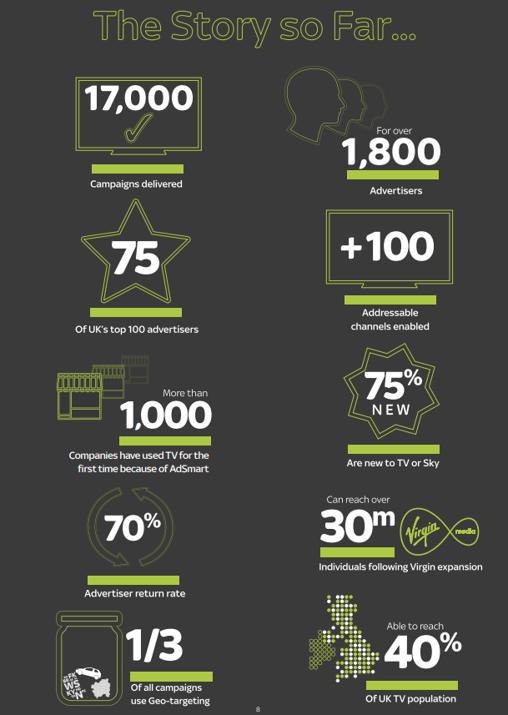
To view the full Five Years & Forward report CLICK HERE.
Opportunity to increase ROI by combining with on-line adverts
2 years of Lock Downs proved that online sales offer not just an alternative to high street retail, but also a means to generate better margins by cutting out wholesalers and retailers.
However, good e-commerce services can take a large amount of time and cost to set up and ensure that the customer experience is first-class. A shortcut can be taken using services like Amazon and leverage on a well-known and trusted platform to run alongside your own e-commerce. Your website also needs to be readied with a landing page, and a simple link and checked that it can handle the predicted volume of hits.
Think about the best call to action. If you are selling products via retail then ensure you match your campaign up with availability and geography and have the actual stock in place through commercial listing agreements, especially, if you are trying to break into retail markets. 0800 Numbers will certainly aid conversion with many types of campaigns, it also can make sense to direct TV Ad viewers to call centers with properly trained staff available during each run of a campaign.
Mixing multi-channel promotions with TV Advertising
Given that we as consumers spend our lives moving between handheld devices and TV, it's essential to blend and extend TV advertising across other digital channels, especially during an initial launch. You ideally want to be omni-present so your advert or versions of it for specific mobile and social platforms is seen where ever your target audience is active. The same work that has to be done to research the best audience profiles for TV can be correlated with Social Media Advertising.
You can plan to reuse the TV advert on YouTube, and email marketing and adapt it for formats that might better suit platforms like TikTok and Instagram.
TV Adverts can also be designed to send viewers to social media and websites for longer-form sales promotions and competitions.
Each type of channel activity can be setup to have a simple means to track successful engagement, for example, each digital channel (including TV) can have a unique QR code added for viewers to access the web offer.
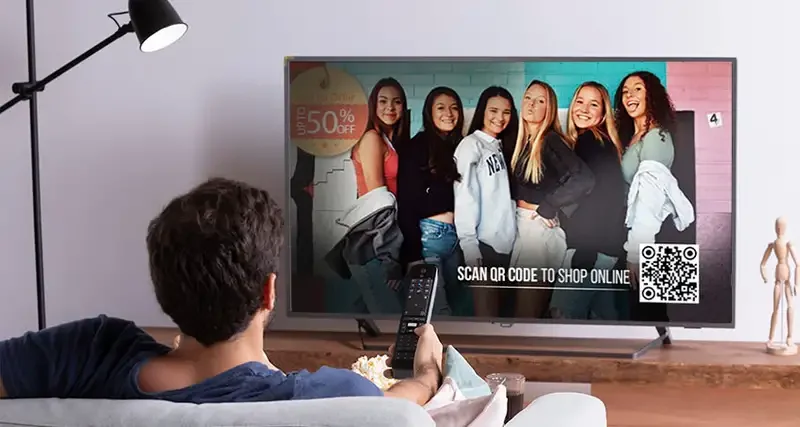
What else helps to make a TV advert campaign work?
INFLUENCERS & CELEBS: Since the birth of advertising, having a well know public figure associated with your product or service can make a huge difference. The way they can be involved varies from being booked to doing a voice-over, to giving simple endorsements or actual appearances. For growing brands, this may not be an easy option because for the large fees involved, but many brands have teamed up with celebs and come to special commercial arrangements, based on a relatively low fee plus commission sales.
PERSISTENCE: It's important to give time for a campaign to work, so planning a sustainable budget and realistic targets, ideally for at least 3 months will help build steady success, rather than praying for overnight success.
POINT OF SALE: TV Advertising has to be part of a process with simple steps taken to transfer awareness into engagement and action by the viewer to the easiest way possible to find and buy the product. For most FMCG products this means that you have established retail outlets and brokered listings with supermarkets or other major stores. A common tactic for getting a major retailer to list your product will be to promise that if they take your products on board you will back sales with TV advertising.
How can I de-risk our first TV advertising campaign?
Before you begin by looking at the parameters that need to be satisfied to class a TV Ad campaign as a success. Research into any similar brands that have made forays into TV Advertising will often help give a proven path to follow. Examine news on the length, budget, scale, and results of their campaign that is in the public domain - look at both successes and failures.
At the outset we recommend a test campaign, then scale to prove an initial business case. The results of nay such pilot then help de-risk any larger investments and help create the profits to sustain growth.
Also work with an agency like us who will help with developing a campaign, using the best available insights from ITV and Sky, combined with your own data.
Then make use of a free comprehensive service which will include a workshop to help create a strong brief from which we will generate a concept, narrative, storyboard, and costing for actual test advertising, validated by a discussion with ITV and /or Sky.

What other factors determine success?
The development of 'personas' for your ideal customers is vital to successful targetting with Addressable TV Ads and indeed any form of digital marketing, such as Google Ads. But with TV the portrayal of these personas has to be forged with the greatest care. There is always a risk that a stereotypical character may emerge that either offends or limits audiences that might otherwise buy your product.
Think about planning ahead for seasonal events that may trigger purchases.
Also what are called 'tent-pole event' for example 'Black Friday'. This means you need to start planning 4-6 months ahead.
Tap into economic factors and seasonal trends.
Remember to give time for any TV Ad campaign to go through development and approval including compliance checks and your own approvals. production and 14 days' notice to the TV company with the ad uploaded and ready to launch on their platform.
The value of compliance to building a 'trusted' branded
One of the things that will set your brand apart when you first appear on TV is that the only adverts allowed to appear are those that have passed strict independent evaluations to ensure that adhere to strict guidelines. 'As seen on TV' gives a certain level of credibility and authenticity over and above all other forms of advertising.
There are two ways this will help build value for your brand.
- Appearing on TV gives a certain stamp of quality assurance. This helps accelerate the growth of any brand by quickly building consumer trust.
- Due to a higher trust factor consumers are more likely to be prepared to pay a premium for products or services.
All TV adverts have to pass approval by Clearcast who ensures the advert makes bonafide claims, for example; 'scientific', 'savings', 'benefits', 'safe for the environment. 'avoid animal cruelty and any product is legal to advertise and has all of the proofs for any such claims.
We take care of, managing liaison with Clearcast to ensure all aspects comply with legal and technical standards.
Join the addressable TV revolution today
We can help you get underway with our comprehensive free support to help build everything thing you need to plan your very first 'pilot addressable TV advert'.
- FREE initial consultation and initial research on feasibility.
- FREE audit of your current digital presence.
- FREE TV Advert design workshop.
- FREE concept, narrative, and storyboard.
- FREE Addressable TV campaign design and estimate, including all production provided in partnership with Sky and ITV, together with supporting case studies.
For more information contact:
JP Allard - Managing Director @ TVNF Ltd 07403 901384

